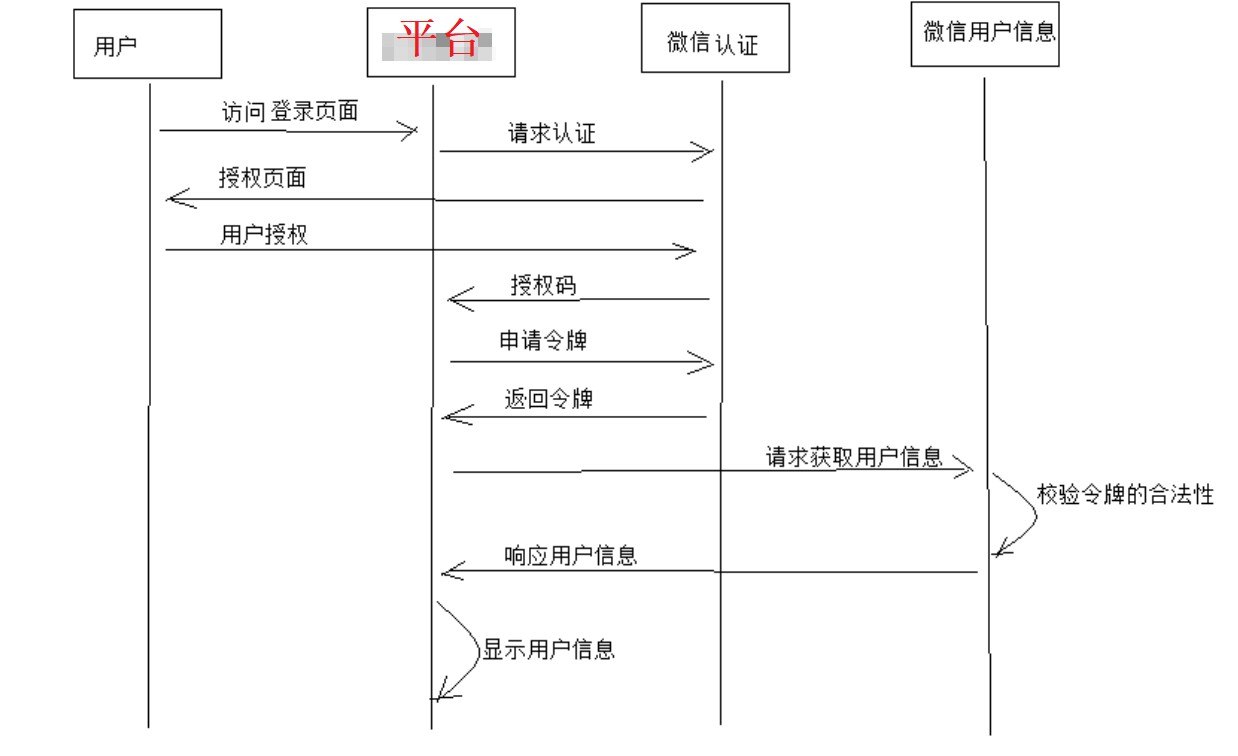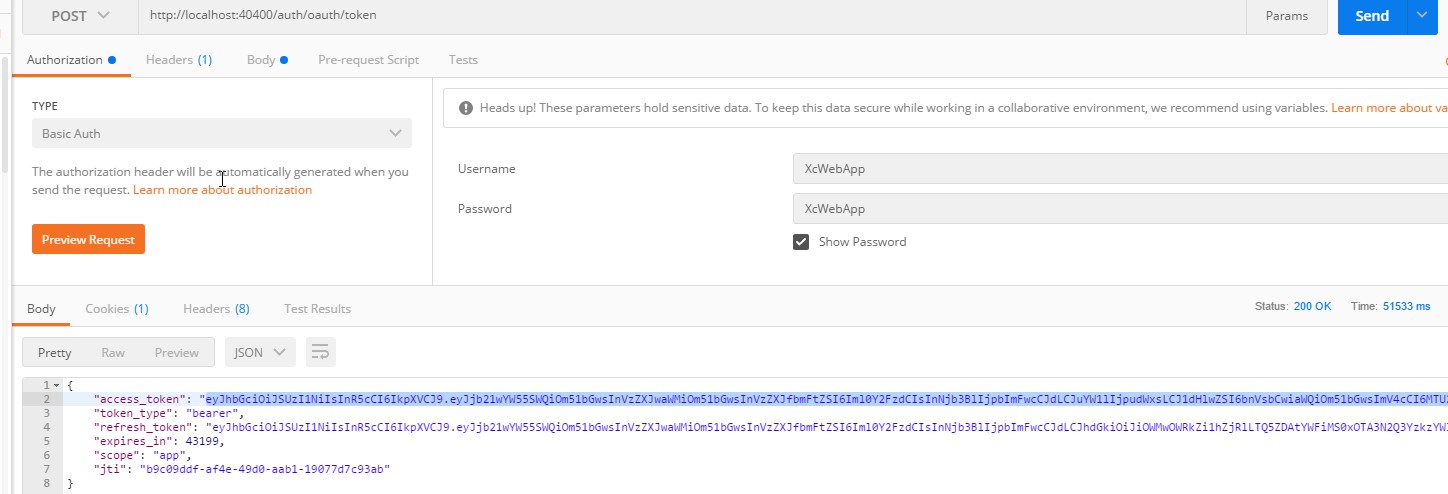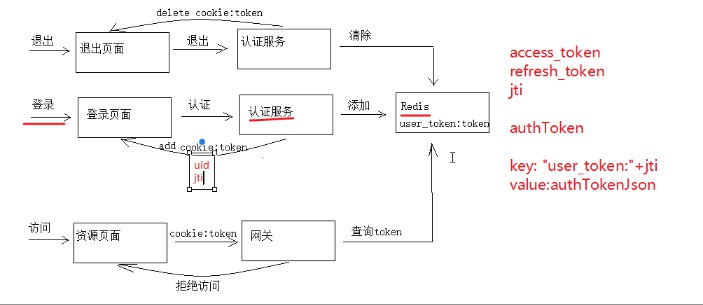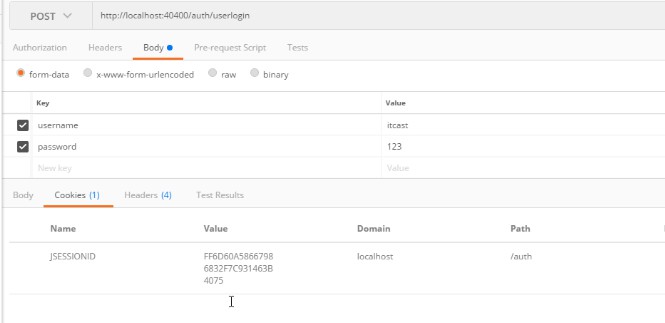一,单点登录概述
(一)什么是单点登录:每个子系统从第三方认证系统中查找而不是每个系统都通过各自的session校验。
(三)单点登录实现框架:
apache Shiro
CAS
springsecurity
二。Oauth2认证微信认证第三方登录
1.授权码模式:资源拥有者(用户)发起微信登录,平台调用微信接口,到达授权页面,手机wx扫码登录用户同意授权,微信会对用户进行验证,通过后给平台一个授权码,平台
携带授权码到微信认证服务申请令牌,并返回令牌到平台,平台再携带令牌调微信用户信息服务,微信用户信息服务校验令牌合法性,响应给平台,
平台显示微信头像。


客户端(平台)拿到授权码去认证服务申请令牌,授权服务通过私钥加密生成令牌,
令牌给客户端,携带令牌访问资源服务
课程服务相当于资源存储公钥(根据公钥校验令牌合法性===公钥把令牌解开,放行;;解不开拒绝服务)

课程服务相当于资源服务
对swagger进行放行
"/swagger-resources","/swagger-resources/configuration/security",
"/swagger-ui.html","/webjars/**","/course/coursepic/list/*").permitAll()
mport org.springframework.context.annotation.Bean; import org.springframework.context.annotation.Configuration; import org.springframework.core.io.ClassPathResource; import org.springframework.core.io.Resource; import org.springframework.security.config.annotation.method.configuration.EnableGlobalMethodSecurity; import org.springframework.security.config.annotation.web.builders.HttpSecurity; import org.springframework.security.oauth2.config.annotation.web.configuration.EnableResourceServer; import org.springframework.security.oauth2.config.annotation.web.configuration.ResourceServerConfigurerAdapter; import org.springframework.security.oauth2.provider.token.TokenStore; import org.springframework.security.oauth2.provider.token.store.JwtAccessTokenConverter; import org.springframework.security.oauth2.provider.token.store.JwtTokenStore; import java.io.BufferedReader; import java.io.IOException; import java.io.InputStreamReader; import java.util.stream.Collectors; @Configuration @EnableResourceServer @EnableGlobalMethodSecurity(prePostEnabled = true, securedEnabled = true)//激活方法上的PreAuthorize注解 public class ResourceServerConfig extends ResourceServerConfigurerAdapter { //公钥 private static final String PUBLIC_KEY = "publickey.txt"; //定义JwtTokenStore,使用jwt令牌 @Bean public TokenStore tokenStore(JwtAccessTokenConverter jwtAccessTokenConverter) { return new JwtTokenStore(jwtAccessTokenConverter); } //定义JJwtAccessTokenConverter,使用jwt令牌 @Bean public JwtAccessTokenConverter jwtAccessTokenConverter() { JwtAccessTokenConverter converter = new JwtAccessTokenConverter(); converter.setVerifierKey(getPubKey()); return converter; } /** * 获取非对称加密公钥 Key * @return 公钥 Key */ private String getPubKey() { Resource resource = new ClassPathResource(PUBLIC_KEY); try { InputStreamReader inputStreamReader = new InputStreamReader(resource.getInputStream()); BufferedReader br = new BufferedReader(inputStreamReader); return br.lines().collect(Collectors.joining(" ")); } catch (IOException ioe) { return null; } } //Http安全配置,对每个到达系统的http请求链接进行校验 @Override public void configure(HttpSecurity http) throws Exception { //所有请求必须认证通过 http.authorizeRequests() .antMatchers("/v2/api-docs", "/swagger-resources/configuration/ui", "/swagger-resources","/swagger-resources/configuration/security", "/swagger-ui.html","/webjars/**","/course/coursepic/list/*").permitAll() .anyRequest().authenticated(); } }
访问课程服务只有:头部KEY:authorization
value:Bear+accesstoken
才可以访问
2.密码算法模式
不用申请授权码,用户名,密码就可以;

jwt中包含了用户信息,可以避免资源服务解决不了验证还要请求认证服务来验证。效率高
是个json串便于解析,易拓展,非对称安全,但长
分为头部(加密算法),负载(自己加),签名(认证服务端签发的唯一防止窃取)。

(一)认证服务的controller
如何申请令牌
clientid,clientpassword
bodyheader封装在HTTPentity
getHttpBasic
MultiValueMap<String, String> body = new LinkedMultiValueMap<>(); body.add("grant_type","password"); body.add("username","itcast"); body.add("password","123"); MultiValueMap<String, String> headers = new LinkedMultiValueMap<>(); headers.add("Authorization",this.getHttpBasic("XcWebApp","XcWebApp")); HttpEntity<MultiValueMap<String, String>> requestEntity = new HttpEntity<>(body,headers);
private String getHttpBasic(String clientId, String clientPassword) {
String value =clientId+":"+clientPassword ;
byte[] encode = Base64Utils.encode(value.getBytes());
return "Basic "+new String(encode);
}
uri
//http://localhost:40400/auth/oauth/token ServiceInstance serviceInstance = loadBalancerClient.choose(XcServiceList.XC_SERVICE_UCENTER_AUTH); // http://localhost:40400 URI uri = serviceInstance.getUri(); String url = uri+"/auth/oauth/token";
ResponseEntity<Map> responseEntity = restTemplate.exchange(url, HttpMethod.POST, requestEntity, Map.class);
Map map = responseEntity.getBody();
1 Override 2 @PostMapping("/userlogin") 3 public LoginResult login(LoginRequest loginRequest) { 4 5 //判断参数 6 if (StringUtils.isEmpty(loginRequest.getUsername())){ 7 ExceptionCast.cast(AuthCode.AUTH_USERNAME_NONE); 8 } 9 if (StringUtils.isEmpty(loginRequest.getPassword())){ 10 ExceptionCast.cast(AuthCode.AUTH_PASSWORD_NONE); 11 } 12 13 //申请令牌 14 AuthToken authToken = authService.login(loginRequest.getUsername(),loginRequest.getPassword(),clientId,clientSecret); 15 16 String jti = authToken.getJti(); 17 18 //将令牌信息存入cookie 19 this.saveTokenToCookie(jti); 20 21 return new LoginResult(CommonCode.SUCCESS,jti); 22 } 23 24 private void saveTokenToCookie(String jti) { 25 HttpServletResponse response = ((ServletRequestAttributes) RequestContextHolder.getRequestAttributes()).getResponse(); 26 27 //httpOnly:false。 允许浏览器获取cookie 28 CookieUtil.addCookie(response,cookieDomain,"/","uid",jti,cookieMaxAge,false); 29 }
测试

实际结果


(二)认证服务的service
public AuthToken login(String username, String password, String clientId, String clientSecret) { //申请令牌 AuthToken authToken = this.applyToken(username,password,clientId,clientSecret); //将令牌存入redis boolean result = this.saveTokenToRedis(authToken); if (!result){ //存入失败 ExceptionCast.cast(AuthCode.AUTH_LOGIN_TOKEN_SAVEFAIL); } return authToken; } //存入redis private boolean saveTokenToRedis(AuthToken authToken) { String key = "user_token:"+authToken.getJti(); String tokenString = JSON.toJSONString(authToken); stringRedisTemplate.boundValueOps(key).set(tokenString,tokenValiditySeconds, TimeUnit.SECONDS); Long expire = stringRedisTemplate.getExpire(key); return expire>0; } //申请令牌 private AuthToken applyToken(String username, String password, String clientId, String clientSecret) { ServiceInstance serviceInstance = loadBalancerClient.choose(XcServiceList.XC_SERVICE_UCENTER_AUTH); URI uri = serviceInstance.getUri(); String url = uri+"/auth/oauth/token"; MultiValueMap<String, String> body = new LinkedMultiValueMap<>(); body.add("grant_type","password"); body.add("username",username); body.add("password",password); MultiValueMap<String, String> headers = new LinkedMultiValueMap<>(); headers.add("Authorization",this.getHttpBasic(clientId,clientSecret)); HttpEntity<MultiValueMap<String,String>> requestEntity = new HttpEntity<>(body,headers); restTemplate.setErrorHandler(new DefaultResponseErrorHandler(){ @Override public void handleError(ClientHttpResponse response) throws IOException { if (response.getRawStatusCode() != 400 && response.getRawStatusCode() != 401){ super.handleError(response); } } }); ResponseEntity<Map> responseEntity = restTemplate.exchange(url, HttpMethod.POST, requestEntity, Map.class); Map map = responseEntity.getBody(); if (map == null || map.get("access_token")==null || map.get("refresh_token")==null || map.get("jti")==null){ ExceptionCast.cast(AuthCode.AUTH_LOGIN_APPLYTOKEN_FAIL); } AuthToken authToken = new AuthToken(); authToken.setAccess_token((String) map.get("access_token")); authToken.setRefresh_token((String) map.get("refresh_token")); authToken.setJti((String) map.get("jti")); return authToken; }
三,具体单点登录实现认证服务
(一)配置文件
1
AuthorizationServerConfig
密钥非对称加密,私钥加密,公钥解密
package com.xuecheng.auth.config; import org.springframework.beans.factory.annotation.Autowired; import org.springframework.cloud.bootstrap.encrypt.KeyProperties; import org.springframework.context.annotation.Bean; import org.springframework.context.annotation.Configuration; import org.springframework.security.authentication.AuthenticationManager; import org.springframework.security.core.userdetails.UserDetailsService; import org.springframework.security.crypto.bcrypt.BCryptPasswordEncoder; import org.springframework.security.oauth2.config.annotation.configurers.ClientDetailsServiceConfigurer; import org.springframework.security.oauth2.config.annotation.web.configuration.AuthorizationServerConfigurerAdapter; import org.springframework.security.oauth2.config.annotation.web.configuration.EnableAuthorizationServer; import org.springframework.security.oauth2.config.annotation.web.configurers.AuthorizationServerEndpointsConfigurer; import org.springframework.security.oauth2.config.annotation.web.configurers.AuthorizationServerSecurityConfigurer; import org.springframework.security.oauth2.provider.ClientDetailsService; import org.springframework.security.oauth2.provider.client.JdbcClientDetailsService; import org.springframework.security.oauth2.provider.token.DefaultAccessTokenConverter; import org.springframework.security.oauth2.provider.token.TokenStore; import org.springframework.security.oauth2.provider.token.store.JwtAccessTokenConverter; import org.springframework.security.oauth2.provider.token.store.JwtTokenStore; import org.springframework.security.oauth2.provider.token.store.KeyStoreKeyFactory; import javax.annotation.Resource; import javax.sql.DataSource; import java.security.KeyPair; @Configuration @EnableAuthorizationServer class AuthorizationServerConfig extends AuthorizationServerConfigurerAdapter { @Autowired private DataSource dataSource; //jwt令牌转换器 @Autowired private JwtAccessTokenConverter jwtAccessTokenConverter; @Autowired UserDetailsService userDetailsService; @Autowired AuthenticationManager authenticationManager; @Autowired TokenStore tokenStore; @Autowired private CustomUserAuthenticationConverter customUserAuthenticationConverter; //读取密钥的配置 @Bean("keyProp") public KeyProperties keyProperties(){ return new KeyProperties(); } @Resource(name = "keyProp") private KeyProperties keyProperties; //客户端配置 @Bean public ClientDetailsService clientDetails() { return new JdbcClientDetailsService(dataSource); } @Override public void configure(ClientDetailsServiceConfigurer clients) throws Exception { clients.jdbc(this.dataSource).clients(this.clientDetails()); /* clients.inMemory() .withClient("XcWebApp")//客户端id .secret("XcWebApp")//密码,要保密 .accessTokenValiditySeconds(60)//访问令牌有效期 .refreshTokenValiditySeconds(60)//刷新令牌有效期 //授权客户端请求认证服务的类型authorization_code:根据授权码生成令牌, // client_credentials:客户端认证,refresh_token:刷新令牌,password:密码方式认证 .authorizedGrantTypes("authorization_code", "client_credentials", "refresh_token", "password") .scopes("app");//客户端范围,名称自定义,必填*/ } //token的存储方法 // @Bean // public InMemoryTokenStore tokenStore() { // //将令牌存储到内存 // return new InMemoryTokenStore(); // } // @Bean // public TokenStore tokenStore(RedisConnectionFactory redisConnectionFactory){ // RedisTokenStore redisTokenStore = new RedisTokenStore(redisConnectionFactory); // return redisTokenStore; // } @Bean @Autowired public TokenStore tokenStore(JwtAccessTokenConverter jwtAccessTokenConverter) { return new JwtTokenStore(jwtAccessTokenConverter); } @Bean public JwtAccessTokenConverter jwtAccessTokenConverter(CustomUserAuthenticationConverter customUserAuthenticationConverter) { JwtAccessTokenConverter converter = new JwtAccessTokenConverter(); KeyPair keyPair = new KeyStoreKeyFactory (keyProperties.getKeyStore().getLocation(), keyProperties.getKeyStore().getSecret().toCharArray()) .getKeyPair(keyProperties.getKeyStore().getAlias(),keyProperties.getKeyStore().getPassword().toCharArray()); converter.setKeyPair(keyPair); //配置自定义的CustomUserAuthenticationConverter DefaultAccessTokenConverter accessTokenConverter = (DefaultAccessTokenConverter) converter.getAccessTokenConverter(); accessTokenConverter.setUserTokenConverter(customUserAuthenticationConverter); return converter; } //授权服务器端点配置 @Override public void configure(AuthorizationServerEndpointsConfigurer endpoints) throws Exception { /*Collection<TokenEnhancer> tokenEnhancers = applicationContext.getBeansOfType(TokenEnhancer.class).values(); TokenEnhancerChain tokenEnhancerChain=new TokenEnhancerChain(); tokenEnhancerChain.setTokenEnhancers(new ArrayList<>(tokenEnhancers)); DefaultTokenServices defaultTokenServices = new DefaultTokenServices(); defaultTokenServices.setReuseRefreshToken(true); defaultTokenServices.setSupportRefreshToken(true); defaultTokenServices.setTokenStore(tokenStore); defaultTokenServices.setAccessTokenValiditySeconds(1111111); defaultTokenServices.setRefreshTokenValiditySeconds(1111111); defaultTokenServices.setTokenEnhancer(tokenEnhancerChain); endpoints .authenticationManager(authenticationManager) .userDetailsService(userDetailsService) //.tokenStore(tokenStore); .tokenServices(defaultTokenServices);*/ endpoints.accessTokenConverter(jwtAccessTokenConverter) .authenticationManager(authenticationManager)//认证管理器 .tokenStore(tokenStore)//令牌存储 .userDetailsService(userDetailsService);//用户信息service } //授权服务器的安全配置 @Override public void configure(AuthorizationServerSecurityConfigurer oauthServer) throws Exception { // oauthServer.checkTokenAccess("isAuthenticated()");//校验token需要认证通过,可采用http basic认证 oauthServer.allowFormAuthenticationForClients() .passwordEncoder(new BCryptPasswordEncoder()) .tokenKeyAccess("permitAll()") .checkTokenAccess("isAuthenticated()"); } }
2
CustomUserAuthenticationConverter
生成令牌信息
package com.xuecheng.auth.config; import com.xuecheng.auth.service.UserJwt; import org.springframework.beans.factory.annotation.Autowired; import org.springframework.security.core.Authentication; import org.springframework.security.core.authority.AuthorityUtils; import org.springframework.security.core.userdetails.UserDetails; import org.springframework.security.core.userdetails.UserDetailsService; import org.springframework.security.oauth2.provider.token.DefaultUserAuthenticationConverter; import org.springframework.stereotype.Component; import java.util.LinkedHashMap; import java.util.Map; @Component public class CustomUserAuthenticationConverter extends DefaultUserAuthenticationConverter { @Autowired UserDetailsService userDetailsService; @Override public Map<String, ?> convertUserAuthentication(Authentication authentication) { LinkedHashMap response = new LinkedHashMap(); String name = authentication.getName(); response.put("user_name", name); Object principal = authentication.getPrincipal(); UserJwt userJwt = null; if(principal instanceof UserJwt){ userJwt = (UserJwt) principal; }else{ //refresh_token默认不去调用userdetailService获取用户信息,这里我们手动去调用,得到 UserJwt UserDetails userDetails = userDetailsService.loadUserByUsername(name); userJwt = (UserJwt) userDetails; } response.put("name", userJwt.getName()); response.put("id", userJwt.getId()); response.put("utype",userJwt.getUtype()); response.put("userpic",userJwt.getUserpic()); response.put("companyId",userJwt.getCompanyId()); if (authentication.getAuthorities() != null && !authentication.getAuthorities().isEmpty()) { response.put("authorities", AuthorityUtils.authorityListToSet(authentication.getAuthorities())); } return response; } }
3
WebSecurityConfig
对登录放行
密码加盐加密
1 import org.springframework.context.annotation.Bean; 2 import org.springframework.context.annotation.Configuration; 3 import org.springframework.core.annotation.Order; 4 import org.springframework.security.authentication.AuthenticationManager; 5 import org.springframework.security.config.annotation.web.builders.HttpSecurity; 6 import org.springframework.security.config.annotation.web.builders.WebSecurity; 7 import org.springframework.security.config.annotation.web.configuration.EnableWebSecurity; 8 import org.springframework.security.config.annotation.web.configuration.WebSecurityConfigurerAdapter; 9 import org.springframework.security.crypto.bcrypt.BCryptPasswordEncoder; 10 import org.springframework.security.crypto.password.PasswordEncoder; 11 12 @Configuration 13 @EnableWebSecurity 14 @Order(-1) 15 class WebSecurityConfig extends WebSecurityConfigurerAdapter { 16 17 @Override 18 public void configure(WebSecurity web) throws Exception { 19 web.ignoring().antMatchers("/userlogin","/userlogout","/userjwt"); 20 21 } 22 @Bean 23 @Override 24 public AuthenticationManager authenticationManagerBean() throws Exception { 25 AuthenticationManager manager = super.authenticationManagerBean(); 26 return manager; 27 } 28 //采用bcrypt对密码进行编码 29 @Bean 30 public PasswordEncoder passwordEncoder() { 31 return new BCryptPasswordEncoder(); 32 } 33 34 @Override 35 public void configure(HttpSecurity http) throws Exception { 36 http.csrf().disable() 37 .httpBasic().and() 38 .formLogin() 39 .and() 40 .authorizeRequests().anyRequest().authenticated(); 41 42 } 43 }
authservice写认证
package com.xuecheng.auth.service; import com.alibaba.fastjson.JSON; import com.xuecheng.filesystem.framework.client.XcServiceList; import com.xuecheng.filesystem.framework.domain.ucenter.ext.AuthToken; import com.xuecheng.filesystem.framework.domain.ucenter.response.AuthCode; import com.xuecheng.filesystem.framework.exception.ExceptionCast; import org.springframework.beans.factory.annotation.Autowired; import org.springframework.beans.factory.annotation.Value; import org.springframework.cloud.client.ServiceInstance; import org.springframework.cloud.client.loadbalancer.LoadBalancerClient; import org.springframework.data.redis.core.StringRedisTemplate; import org.springframework.http.HttpEntity; import org.springframework.http.HttpMethod; import org.springframework.http.ResponseEntity; import org.springframework.http.client.ClientHttpResponse; import org.springframework.stereotype.Service; import org.springframework.util.Base64Utils; import org.springframework.util.LinkedMultiValueMap; import org.springframework.util.MultiValueMap; import org.springframework.web.client.DefaultResponseErrorHandler; import org.springframework.web.client.RestTemplate; import java.io.IOException; import java.net.URI; import java.util.Map; import java.util.concurrent.TimeUnit; @Service public class AuthService { @Autowired private RestTemplate restTemplate; @Autowired private LoadBalancerClient loadBalancerClient; @Autowired private StringRedisTemplate stringRedisTemplate; @Value("${auth.tokenValiditySeconds}") private long tokenValiditySeconds; /** * 用户认证登录,申请令牌 * @param username * @param password * @param clientId * @param clientSecret * @return */ public AuthToken login(String username, String password, String clientId, String clientSecret) { //申请令牌 AuthToken authToken = this.applyToken(username,password,clientId,clientSecret); //将令牌存入redis boolean result = this.saveTokenToRedis(authToken); if (!result){ //存入失败 ExceptionCast.cast(AuthCode.AUTH_LOGIN_TOKEN_SAVEFAIL); } return authToken; } //存入redis private boolean saveTokenToRedis(AuthToken authToken) { String key = "user_token:"+authToken.getJti(); String tokenString = JSON.toJSONString(authToken); stringRedisTemplate.boundValueOps(key).set(tokenString,tokenValiditySeconds, TimeUnit.SECONDS); Long expire = stringRedisTemplate.getExpire(key); return expire>0; } //申请令牌 private AuthToken applyToken(String username, String password, String clientId, String clientSecret) { ServiceInstance serviceInstance = loadBalancerClient.choose(XcServiceList.XC_SERVICE_UCENTER_AUTH); URI uri = serviceInstance.getUri(); String url = uri+"/auth/oauth/token"; MultiValueMap<String, String> body = new LinkedMultiValueMap<>(); body.add("grant_type","password"); body.add("username",username); body.add("password",password); MultiValueMap<String, String> headers = new LinkedMultiValueMap<>(); headers.add("Authorization",this.getHttpBasic(clientId,clientSecret)); HttpEntity<MultiValueMap<String,String>> requestEntity = new HttpEntity<>(body,headers); restTemplate.setErrorHandler(new DefaultResponseErrorHandler(){ @Override public void handleError(ClientHttpResponse response) throws IOException { if (response.getRawStatusCode() != 400 && response.getRawStatusCode() != 401){ super.handleError(response); } } }); ResponseEntity<Map> responseEntity = restTemplate.exchange(url, HttpMethod.POST, requestEntity, Map.class); Map map = responseEntity.getBody(); if (map == null || map.get("access_token")==null || map.get("refresh_token")==null || map.get("jti")==null){ ExceptionCast.cast(AuthCode.AUTH_LOGIN_APPLYTOKEN_FAIL); } AuthToken authToken = new AuthToken(); authToken.setAccess_token((String) map.get("access_token")); authToken.setRefresh_token((String) map.get("refresh_token")); authToken.setJti((String) map.get("jti")); return authToken; } private String getHttpBasic(String clientId, String clientSecret) { String value = clientId+":"+clientSecret; byte[] encode = Base64Utils.encode(value.getBytes()); return "Basic "+new String(encode); } public AuthToken getTokenFormRedis(String jti) { String key="user_token:"+jti; String tokenString = stringRedisTemplate.boundValueOps(key).get(); AuthToken authToken = JSON.parseObject(tokenString, AuthToken.class); return authToken; } public void delTokenFromRedis(String jti) { String key="user_token:"+jti; stringRedisTemplate.delete(key); } }
userjwt用户信息融到令牌中
import lombok.Data; import lombok.ToString; import org.springframework.security.core.GrantedAuthority; import org.springframework.security.core.userdetails.User; import java.util.Collection; @Data @ToString public class UserJwt extends User { private String id; private String name; private String userpic; private String utype; private String companyId; public UserJwt(String username, String password, Collection<? extends GrantedAuthority> authorities) { super(username, password, authorities); } }
yml配置
1访问路径,redis信息
2auth设置redis过期时间==session过期时间(过期重新登录用)
3私钥位置
4cookie域名(适配到不同域中)和maxage
server: port: ${PORT:40400} servlet: context-path: /auth spring: application: name: xc-service-ucenter-auth redis: host: ${REDIS_HOST:127.0.0.1} port: ${REDIS_PORT:6379} timeout: 5000 #连接超时 毫秒 jedis: pool: maxActive: 3 maxIdle: 3 minIdle: 1 maxWait: -1 #连接池最大等行时间 -1没有限制 datasource: druid: url: ${MYSQL_URL:jdbc:mysql://localhost:3306/xc_user?characterEncoding=utf-8} username: root password: root driverClassName: com.mysql.jdbc.Driver initialSize: 5 #初始建立连接数量 minIdle: 5 #最小连接数量 maxActive: 20 #最大连接数量 maxWait: 10000 #获取连接最大等待时间,毫秒 testOnBorrow: true #申请连接时检测连接是否有效 testOnReturn: false #归还连接时检测连接是否有效 timeBetweenEvictionRunsMillis: 60000 #配置间隔检测连接是否有效的时间(单位是毫秒) minEvictableIdleTimeMillis: 300000 #连接在连接池的最小生存时间(毫秒) auth: tokenValiditySeconds: 1200 #token存储到redis的过期时间 clientId: XcWebApp clientSecret: XcWebApp cookieDomain: xuecheng.com cookieMaxAge: -1 encrypt: key-store: location: classpath:/xc.keystore secret: xuechengkeystore alias: xckey password: xuecheng eureka: client: registerWithEureka: true #服务注册开关 fetchRegistry: true #服务发现开关 serviceUrl: #Eureka客户端与Eureka服务端进行交互的地址,多个中间用逗号分隔 defaultZone: ${EUREKA_SERVER:http://localhost:50101/eureka/,http://localhost:50102/eureka/} instance: prefer-ip-address: true #将自己的ip地址注册到Eureka服务中 ip-address: ${IP_ADDRESS:127.0.0.1} instance-id: ${spring.application.name}:${server.port} #指定实例id ribbon: MaxAutoRetries: 2 #最大重试次数,当Eureka中可以找到服务,但是服务连不上时将会重试,如果eureka中找不到服务则直接走断路器 MaxAutoRetriesNextServer: 3 #切换实例的重试次数 OkToRetryOnAllOperations: false #对所有操作请求都进行重试,如果是get则可以,如果是post,put等操作没有实现幂等的情况下是很危险的,所以设置为false ConnectTimeout: 5000 #请求连接的超时时间 ReadTimeout: 6000 #请求处理的超时时间
